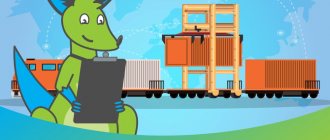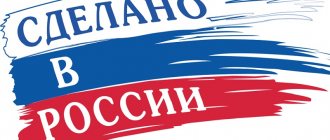In the Republic of Kazakhstan, an electronic invoice is issued in accordance with the requirements approved by the Rules for issuing invoices in electronic form in the information system of electronic invoices and its forms (Order No. 370 dated April 22, 2019).
However, filling out this document has a number of features. Some of them are related to the sources of origin of the goods sold.
In the article we will explain and show in detail how to use the mechanisms for maintaining records of goods in the context of sources of origin in the “1C: Accounting 8 edition 3.0 for Kazakhstan” configuration. New knowledge will help you correctly keep records of data on goods and fill out the ESF taking into account the available data.
Accounting settings
How to switch to accounting for goods by source of origin?
At the beginning of work, it is necessary to set the start date for using the mechanism and enter the initial information. To do this, we will use the Transition Assistant (section Enterprise – Setting up accounting parameters
).
You should start working on the organization's goods by source of origin by filling out the Organization's Goods (BU) register.
In the transition assistant, create the document Entering initial balances
, which is filled with the balances of inventory according to accounting as of the transition date.
Here, information on sources of origin is not filled in. If the sources of origin of the balances in the warehouse are reliably known, then you can specify them manually.
Document Entering opening balances
is created for each organization and for each structural unit separately.
To do this, indicate the required organization or division in the Structural unit
. If this is not done, then documents are created for all organizations of the information base and their structural divisions.
You can open this document using the hyperlink Documents for entering initial balances
. If necessary, it can be adjusted.
Filling out information on goods included in the List of Exemptions
To indicate goods included in the List of Exemptions, a new information register has been added to the configuration “1C: Accounting 8 edition 3.0 for Kazakhstan” Goods with a reduced duty rate
(List of withdrawals) (section
Buying and selling - Directories and settings
).
You can fill out the register in different ways:
- Fill in with goods from the list of exemptions
- the register is cleared and filled with goods for which the HS code, which is included in the List, is filled in; - Add goods from the withdrawal list
- the previously specified data remains in the register, and items are added for which the HS code included in the list is filled in.
the List of withdrawals button
the approved List of exemptions indicating the codes and names of goods included in it will be available in the register.
When specifying the HS code for an item, if this code is included in the List, then the item card displays the inscription The product is included in the list of exemptions.
This inscription will also be displayed in the classifier selection form.
How to write out SNT for goods from the List of Exemptions. Step by step guide
A pilot project for issuing SNT (accompanying invoices for goods) for goods from the List of Exemptions started on October 1, 2021. Before starting documentation, taxpayers must:
- Provide employees in the ESF IS with the rights to work with accompanying invoices for goods;
- Create virtual warehouses and stock them with remaining products;
- Determine the timing of registration of SNT and cases in which accompanying invoices for goods are not needed;
- Find out about liability for refusal to issue or violation of deadlines for registration of SNT;
- Learn how to draw up an ESF without reference or with reference to SNT;
- Learn how to correctly make corrections (and how many times you can), recall, reject and receive documentation;
- Understand in what situations the buyer is and is not required to confirm SNT;
- Learn to issue accompanying invoices for goods, including for various categories of buyers.
Our article contains instructions for performing each of the above steps.
To work in the pilot on accompanying invoices for goods, we advise you to carefully follow the Rules of the pilot project for SNT (Order No. 1104 of November 16, 2020)
Start working with accompanying invoices for goods in 1C. Order the setup of a Virtual Warehouse from the managers of First Bit.
Providing employees in the ESF IS with the right to work with SNT
Before starting work with SNT, your suppliers, storekeepers, accountants or other specialists must register with the ESF IS. The procedure is standard and ends with an “invitation” from the employee to become an employee of the taxpayer’s enterprise.
Assigning the right to an individual to carry out transactions in the ESF IS on behalf of the organization
A taxpayer can grant an individual the rights to work in the ESF IS on behalf of an enterprise after the first person confirms himself as an employee. Rights available for assignment:
- Formation and confirmation of SNT;
- Preparation of a draft according to SNT;
- View SNT.
The choice of rights granted is up to the taxpayer. For example, a storekeeper can be tasked with creating drafts of accompanying invoices for goods. And sending such documents to an accountant.
Setting rights on behalf of an organization
In the absence of employees, the formation of SNT is carried out by the entrepreneur himself. No additional permission settings are needed.
Creation of virtual warehouses
In the ESF IS system, each taxpayer receives one “Unassigned warehouse” - a virtual warehouse created automatically by the system. An unassigned warehouse is an “intermediate” warehouse, not a “working” one. Those. It is impossible to perform any actions with it, for example, selling products.
Transfer of automatically registered goods that need to be accounted for in the Virtual Warehouse module from the “Undistributed Goods” warehouse
The taxpayer must create a virtual warehouse for handling goods himself. Initially, the number of accounting warehouses and other “storage points” had to correspond to the number of virtual warehouses.
But subsequently changes were made - the taxpayer, at his own discretion, decides the issue of the number of virtual warehouses to work with and creates them in the system. The exception is excisable goods. There must be a clear correspondence between them: “the number of licenses is equal to the number of virtual warehouses.”
You can create a virtual warehouse:
- In the taxpayer's accounting system (1C);
- In IS ESF.
In the accounting system, a virtual warehouse can be created using the settings of virtual warehouses and the Receiving Assistant (API).
It is necessary to take into account the types and characteristics of virtual warehouses. In the system, warehouses are classified by type and purpose. Let’s say that in order for the counterparty to have the opportunity to indicate your virtual warehouse in the accompanying invoice for the goods, it must have the “Public warehouse” attribute. In SNT it is designated as a virtual warehouse of an enterprise. So is the buyer’s public virtual warehouse. When registering in the ESF IS, public warehouses are selected after specifying the IIN/BIN of the counterparties.
In the 1C program, virtual warehouses of counterparties must be loaded into the accounting system in advance.
Displaying balances of goods from the List of Withdrawals to virtual warehouses
The most difficult step in preparing to work with SNT is the removal of product residues to the aircraft.
The need to enter information on product balances into virtual warehouses
SNT can be issued only for those products that are reflected in the taxpayer’s virtual warehouses. In other words, if a product is not listed in a virtual warehouse, then it is impossible to issue documentation for it.
Entering balances of goods from the List of Exemptions on the Aircraft is mandatory. For other products, there is no need to enter balances into virtual warehouses.
At the same time, the taxpayer has the right to deposit all balances of products (even for those for which there is no such obligation) into virtual warehouses and to issue SNT without separating goods by type. Balances can be deposited onto the aircraft “in whole” or, if necessary, “in parts”.
Let's say you decide to deposit the balance in parts. There are actually 600 units in warehouses. products. The plans are to sell 10 pieces. goods. To issue accompanying invoices for 10 pcs. sold products, you need to enter information in advance on balances of 10 units. When selling further, you will have to re-specify the required number of balances in the virtual warehouse.
Introducing residues into the system is allowed using different methods. In particular, the choice of method depends on accounting in the 1C program:
- Entering product balances can be done directly into the ESF IS using the document Form BC The balance for each batch of products must be entered “manually” with all information on the product recorded: sign of origin, quantity, unit of measurement, HS code, etc. If there are a lot of goods, it will take a long time to enter data “manually”.
- Product balances can be entered from the 1C accounting system. A more efficient and simpler solution for entering information. In other words, information on products is generated in the 1C program and, using a special EDVS document, is sent to the ESF IS module “Virtual Warehouse”.
If you have not yet worked with accompanying invoices for goods in 1C and have not carried out product accounting in a virtual warehouse, you can create balances using the transition assistant. At the final stage of the assistant, EDV documentation is drawn up for all virtual warehouses, which is sent to the ESF IS for entering product data. Those. Documentation is sent in one go, and all required balances immediately appear in the virtual warehouse module. Using this method, you can send information to the system only on aircraft products or the remains of all products.
If you have already worked with SNT before and transferred 1C to accounting for goods in a virtual warehouse, then its VS in the ESF IS will already have balances for certain product groups. To fully enter balances for goods from the List of Exemptions into the system, an EDV document is used, which is created independently for each aircraft.
When purchasing a product from a supplier, information on it will automatically be sent to the aircraft via SNT. For this product, no additional operations are required to enter information into the system.
Dates and deadlines for issuing SNT for goods from the List of Exemptions
From October 1, 2021, SNT for goods from the List of Exemptions is issued:
- When exporting products to the EAEU (except for their export by passenger transport);
- When selling products in Kazakhstan (except for retail sales);
- When importing products into the EAEU (with the exception of their export by passenger transport);
- When exporting products to other states.
Important: the sale of goods from the List of Exemptions in Kazakhstan is a Pilot under SNT. Whereas all imports and exports of products are classified as “combat”, i.e. mandatory documentation.
The difference between a mandatory discharge and a pilot is the presence and absence of administrative liability (fines), respectively.
In the pilot for operations in Kazakhstan, accompanying invoices for goods from the List of Exemptions are NOT issued:
- For retail sales of products (distribution to the final consumer);
- When moving products between warehouses of the same taxpayer;
- When moving products between structural divisions.
VOLUNTARY issuance of SNT is allowed for retail sales of products to the end consumer.
The time for issuing accompanying invoices for goods is influenced by such factors as: the goods crossing the state borders of Kazakhstan, the method of moving the products, and their recipient.
Registration of SNT for goods from the List of Exemptions
Taxpayers are required to issue SNT when selling products in Kazakhstan. Let's talk about the movement of documentation.
SNT “reserves” products in the supplier’s virtual warehouse and writes them off from the reserve (and completely from the aircraft) upon receipt of confirmation from the buyer. If the buyer’s confirmation for the transaction is not needed, the products are immediately written off from the virtual warehouse when the documentation is registered by the supplier.
It is allowed to issue accompanying invoices for the goods:
- In 1C accounting system;
- In the ESF IS system.
A document issued in IS ESF can be transferred to 1C.
Please note: in order to issue SNT on the taxpayer's aircraft, there must be corresponding product balances. If there is no goods on the aircraft, the documentation cannot be completed. When issuing accompanying invoices for goods in the accounting system, SNT is sent to the ESF IS. In case of successful sending, the documentation carries out equal actions for write-off in the ESF IS and in the 1C accounting system (in the latter case, movements are generated by sources of origin).
Sources of origin of products - a system for working with SNT and virtual invoices, which makes it possible to correctly fill out information on product batches.
When issuing accompanying invoices for goods from the accounting system (after confirmation by the recipient), the products are written off from the aircraft to the ESF IS. In the accounting system, it is written off according to its source of origin. Accordingly, in both cases it is disposed of.
Set up work with electronic invoices and work completion certificates in 1C.
Order an exchange from First Bit managers and save time and resources.
According to the information accompanying invoices for the goods, the products are “written off” from the supplier’s aircraft and “accounted for” at the recipient’s warehouse.
SNT for goods from the List of exceptions that must be confirmed by the buyer
When preparing accompanying invoices for goods, the supplier’s products are “reserved” on the aircraft and remain in this form until the buyer confirms the documentation.
Products in reserve cannot be selected in another document or written off by the supplier. It “hangs” in reserve and awaits action from its recipient. After the buyer confirms the accompanying invoices, the reserve goods are written off from the supplier's aircraft and automatically moved to the buyer's aircraft.
In some cases, due to objective circumstances, the buyer is not able to confirm the SNT. Let’s say that accompanying invoices for goods from the List of Exemptions are voluntarily issued for retail sales (“consolidated” per day). The buyer in such documentation will be “impersonal”; he simply does not exist. This means that SNT does not need confirmation.
Provided that the documentation does not need to be confirmed by the buyer, no reserve is created. Products are automatically written off from the virtual warehouse according to certain rules.
Receipt (rejection, confirmation) of SNT with goods from the List of Exemptions
When purchasing goods from the List of Exemptions, from October 1, 2021, the supplier is required to issue SNT for the buyer. The incoming document must be confirmed by the buyer (if the documentation is completed correctly) or rejected by him (if the invoice contains significant errors or is sent incorrectly). The buyer has a specific number of days for both of these actions.
If the incoming documents are confirmed, the products are automatically transferred to the buyer’s aircraft. This means that additional steps to enter balances are not necessary.
If incoming documents are rejected, the products are NOT transferred to the buyer's aircraft. For the supplier, it is again an “available balance”, being removed from the reserve.
Confirmation and rejection of incoming accompanying invoices for goods from the List of Exemptions can be done:
- In 1C accounting system;
- In the ESF IS system.
When SNT is confirmed in the accounting system, a new source of origin is created for all batches of products (each line in the documentation). If SNT is rejected in the accounting system, sources of origin are not generated.
Amendments to the SNT with goods from the List of Exemptions
If the taxpayer made an error when creating documentation, for example, the quantity or cost of goods was incorrectly indicated, the SNT must be changed.
Please note: changes to the document are allowed only until the recipient rejects or confirms it. After this, it will no longer be possible to amend the documentation.
If there is a critical error in the SNT (the document was created for the wrong buyer, issued on behalf of another supplier, etc.) that cannot be corrected, the documentation must be recalled. Afterwards, issue a new accompanying invoice for the goods.
Repeated changes to the SNT are allowed (correction of an already corrected document). When amendments are made, the earlier version of the documentation automatically becomes invalid. It is “replaced” by a new edition of the document.
Registration of ESF according to SNT information with goods from the List of Exemptions
For products from the List of Exemptions, taxpayers must create ESF (electronic invoices). SNT and ESF are interconnected with each other. Thus, between the documentation, several checks are carried out to ensure compliance with product information. The ESF IS system offers two ways to issue ESF for a transaction:
- Using the “NON SNT” mechanism - without reference to SNT.
- With reference to SNT (here the information on products in the documents must completely match).
The “NON SNT” system is a temporary mechanism used during the period of the SNT pilot. The use of the system makes it possible to issue ESF for any goods (products from the List of Exemptions and other goods), and SNT - only for products from the List of Exemptions.
But, according to the clarification of the State Revenue Committee of the Ministry of Finance of Kazakhstan, the “NON SNT” system is applied only on the condition that other products are also voluntarily added to the taxpayer’s aircraft. In other words, the ESF allows the indication of other goods only if they are voluntarily entered into a virtual warehouse. Therefore, the same products will be reflected in SNT.
Extract of ESF on the basis of SNT (without reference or with reference) is allowed in the taxpayer’s accounting system and in the ESF IS system.
Liability for violation of deadlines, refusal to issue SNT for goods from the List of Exemptions
The issuance of SNT in the pilot project is the responsibility of taxpayers. But there is currently no administrative liability for refusal to complete documentation or violation of deadlines for issuing accompanying invoices for goods. Accordingly, there are no penalties.
Upon completion of the pilot project, taxpayers will be required to issue “combat” invoices for goods. This means that for refusal to complete documentation or for violating the deadlines for issuing SNT, taxpayers who violate them will receive fines and will bear administrative responsibility.
To summarize: in the “combat” design of SNT there will be fines and administrative liability. In the current pilot there are no administrative penalties or fines.
Call the managers of First Bit regarding automation of warehouse, management, and financial accounting processes.
Formation of sources of origin upon receipt of goods
Storing information about sources of origin
To store information on the sources of origin of goods, the Sources of Origin
(section
Buying and selling - Directories and settings
).
The directory is used to organize an analytical section by batches of inventory receipts, which does not depend on the chosen method for calculating the cost of inventories in accounting. Accounting for inventories by source of origin
maintained in quantitative terms in the specialized register
Goods of the organization BU
.
Each directory element has the following product data:
- Customs declaration number/Import application number/Certificate number
– the line indicates the registration number of the import document or the certificate number if the goods were manufactured on the territory of the Republic of Kazakhstan; - Country of origin
– indicates the country of origin of the product. The value is selected from the World Countries Classifier directory; - ESF registration number
– indicates the registration number assigned to the electronic invoice of the ESF IS. The details are filled in if an ESF was received upon purchasing the goods; - Product name
– the name from the Declaration of Goods or from the Application for the Import of Goods; - Method of origin
– indicate the method of origin of the goods using one of the specified values: Imported at CCT rates; - Imported at WTO rates;
- Imported from CU countries;
- Produced in the Republic of Kazakhstan.
— the indication of the origin of the goods is indicated by one of the following values:
- 1 – Goods included in the List, imported into the territory of the Republic of Kazakhstan;
– filled in with the line number in the Declaration of Goods, or in the Application for Import, in which the goods are specified;
is the code specified in the Declaration of Goods or in the Application for Import when registering the import of goods into the territory of the Republic of Kazakhstan.
In the “1C: Accounting 8 edition 3.0 for Kazakhstan” system, the sources of origin of goods in most cases are generated automatically based on data on their receipt.
Formation of sources of origin when importing goods from EAEU member countries
When an organization purchases goods from EAEU countries, the sources of origin of the goods are generated automatically based on the data in the document Statement on the import of goods and payment of indirect taxes
.
The following indications of the origin of goods may be indicated here:
- 1 - for goods included in the List of Exemptions
imported into the territory of the Republic of Kazakhstan; - 2 - for goods not included in the List of Exemptions
imported into the territory of the Republic of Kazakhstan; - 5 - for goods not related to other criteria.
To fill in the attribute of origin, you must use the command Fill - Fill in attribute of origin
.
You can fill all the lines in the document or only the lines with empty values.
The sign of origin is indicated automatically
depending on whether the product is included in
the List of Exemptions
.
Note! A product is considered included in the List if it is included in the information register Goods with a reduced duty rate
(List of exemptions) with the established attribute
Included in the list
.
If the product is included in the List, the value 1 is indicated in the attribute of origin; if not, 2.
If you post a document but do not fill in the attribute of origin, the system will automatically fill in the attribute of origin according to the algorithm described above.
Formation of sources of origin when importing goods from “third” countries
In this case, the source of origin is generated automatically by the system based on the information specified in the import customs declaration document.
This happens in a similar way to the document Application for the import of goods and payment of indirect taxes.
Formation of sources of origin in the production of goods
During production, the sources of origin are filled in independently.
For this purpose, in the documents Production report for the shift, Receipt of goods from processing
, in the tabular parts there is a column
Source of origin.
You will need to create a new source of origin for the released products.
The attribute of origin of the goods can have the following values:
- 3 - for goods produced on the territory of the Republic of Kazakhstan included in the List of Exemptions;
- 4 - for goods produced on the territory of the Republic of Kazakhstan that are not included in the List of Exemptions;
- 5 - for goods related to other characteristics.
Formation of sources of origin when purchasing on the territory of the Republic of Kazakhstan
If the goods were purchased in the Republic of Kazakhstan, then the initial information about the origin of the goods is filled in based on the data from the received ESF
.
Then the data is transferred to the Receipt of Inventory and Services document.
Formation of a source of origin based on the incoming ESF is performed using the command Sources of origin - Find, create, update
located in section
G Products
.
Structure of the Commodity Nomenclature of Foreign Economic Activity
The code consists of 10 digits, each of them means something. Let's look at the structure of the product range with examples.
First two digits . Designate a product group. There are 97 groups in total, which are combined into 21 sections. For example, code 50 is a group of silk included in section 11 - textile materials.
The first four digits. Expand the product group to a product item. For example, 50 - silk, adding two more digits 07, we get code 5007 - fabrics made from silk threads or from silk waste.
The first six digits reveal the product subitem. For example, code 500720 - silk fabrics with 85% silk thread content.
Ten digits - the code that is indicated in the customs declaration. This is the encoded name of a specific product. Code 5007204100 - translucent (lace) silk fabrics with 85% silk thread content.
Write-off of sources of origin upon disposal of goods
When conducting the document Sales of Inventory and Inventory and Services
(Write-off of goods and materials), information about the sources of origin from which goods will be written off is filled in automatically.
Automatic filling occurs according to the following scenario:
- Goods that have a Source of Origin and the Attribute of Origin value are filled in are written off;
- Goods that have a Source of Origin are written off, but the Attribute of Origin value is not filled in;
- Products that do not have a source of origin are written off.
Sources of origin can also be changed manually.
the Origins button
you can change the source taking into account the remaining items in the
Goods register of the accounting organization
, or for all sources of origin.
When creating an Electronic Invoice
, product data is transferred from the specified source of origin.
Movement of goods by source of origin
Here you can use the document Transfer of Inventory Materials
.
The source of origin is adjusted in the Sources of origin
.
In the Source of Origin
, the source to which the goods must be moved is indicated.
Why is it important today to correctly configure sources of origin in 1C?
We remind you that from August 1, it is planned to introduce obligations to issue accompanying invoices for goods (SNT), the issue will take place in the Virtual Warehouse module of the ESF IS. In order for the formation of SNT to proceed correctly in 1C, the source of origin must be configured for each product, otherwise the required product will not be reflected in the system.
Now you know how to work with sources of origin in the “1C: Accounting 8 edition 3.0 for Kazakhstan” configuration.
If you have any questions, ask them to the First Bit specialists.







